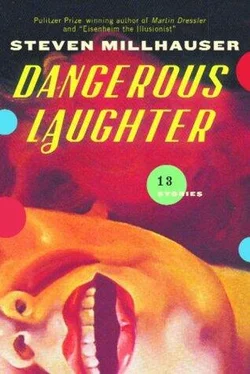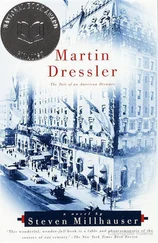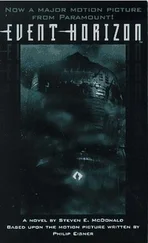Steven Millhauser
Dangerous Laughter
THE CAT IS CHASINGthe mouse through the kitchen: between the blue chair legs, over the tabletop with its red-and-white-checkered tablecloth that is already sliding in great waves, past the sugar bowl falling to the left and the cream jug falling to the right, over the blue chair back, down the chair legs, across the waxed and butter-yellow floor. The cat and the mouse lean backward and try to stop on the slippery wax, which shows their flawless reflections. Sparks shoot from their heels, but it’s much too late: the big door looms. The mouse crashes through, leaving a mouse-shaped hole. The cat crashes through, replacing the mouse-shaped hole with a larger, cat-shaped hole. In the living room they race over the back of the couch, across the piano keys (delicate mouse tune, crash of cat chords), along the blue rug. The fleeing mouse snatches a glance over his shoulder, and when he looks forward again he sees the floor lamp coming closer and closer. Impossible to stop — at the last moment he splits in half and rejoins himself on the other side. Behind him the rushing cat fails to split in half and crashes into the lamp: his head and body push the brass pole into the shape of a trombone. For a moment the cat hangs sideways there, his stiff legs shaking like the clapper of a bell. Then he pulls free and rushes after the mouse, who turns and darts into a mousehole in the baseboard. The cat crashes into the wall and folds up like an accordion. Slowly he unfolds, emitting accordion music. He lies on the floor with his chin on his upraised paw, one eyebrow lifted high in disgust, the claws of his other forepaw tapping the floorboards. A small piece of plaster drops on his head. He raises an outraged eye. A framed painting falls heavily on his head, which plunges out of sight between his shoulders. The painting shows a green tree with bright red apples. The cat’s head struggles to rise, then pops up with the sound of a yanked cork, lifting the picture. Apples fall from the tree and land with a thump on the grass. The cat shudders, winces. A final apple falls. Slowly it rolls toward the frame, drops over the edge, and lands on the cat’s head. In the cat’s eyes, cash registers ring up NO SALE.
The mouse, dressed in a bathrobe and slippers, is sitting in his plump armchair, reading a book. He is tall and slim. His feet rest on a hassock, and a pair of spectacles rest on the end of his long, whiskered nose. Yellow light from a table lamp pours onto the book and dimly illuminates the cozy brown room. On the wall hang a tilted sampler bearing the words HOME SWEET HOME, an oval photograph of the mouse’s mother with her gray hair in a bun, and a reproduction of Seurat’s Sunday Afternoon in which all the figures are mice. Near the armchair is a bookcase filled with books, with several titles visible: Martin Cheddarwit, Gouda’s Faust, The Memoirs of Anthony Edam, A History of the Medicheese, the sonnets of Shakespaw. As the mouse reads his book, he reaches without looking toward a dish on the table. The dish is empty: his fingers tap about inside it. The mouse rises and goes over to the cupboard, which is empty except for a tin box with the word CHEESE on it. He opens the box and turns it upside down. Into his palm drops a single toothpick. He gives it a melancholy look. Shaking his head, he returns to his chair and takes up his book. In a bubble above his head a picture appears: he is seated at a long table covered with a white tablecloth. He is holding a fork upright in one fist and a knife upright in the other. A mouse butler dressed in tails sets before him a piece of cheese the size of a wedding cake.
From the mousehole emerges a red telescope. The lens looks to the left, then to the right. A hand issues from the end of the telescope and beckons the mouse forward. The mouse steps from the mousehole, collapses the telescope, and thrusts it into his bathrobe pocket. In the moonlit room he tiptoes carefully, lifting his legs very high, over to the base of the armchair. He dives under the chair and peeks out through the fringe. He emerges from beneath the armchair, slinks over to the couch, and dives under. He peeks out through the fringe. He emerges from beneath the couch and approaches the slightly open kitchen door. He stands flat against the doorjamb, facing the living room, his eyes darting left and right. One leg tiptoes delicately around the jamb. His stretched body snaps after it like a rubber band. In the kitchen he creeps to a moonlit chair, stands pressed against a chair leg, begins to climb. His nose rises over the tabletop: he sees a cream pitcher, a gleaming knife, a looming pepper mill. On a breadboard sits a wedge of cheese. The mouse, hunching his shoulders, tiptoes up to the cheese. From a pocket of his robe he removes a white handkerchief that he ties around his neck. He bends over the cheese, half closing his eyes, as if he were sniffing a flower. With a crashing sound the cat springs onto the table. As he chases the mouse, the tablecloth bunches in waves, the sugar bowl topples, and waterfalls of sugar spill to the floor. An olive from a fallen cocktail glass rolls across the table, knocking into a cup, a saltshaker, a trivet: the objects light up and cause bells to ring, as in a pinball machine. On the floor a brigade of ants is gathering the sugar: one ant catches the falling grains in a bucket, which he dumps into the bucket of a second ant, who dumps the sugar into the bucket of a third ant, all the way across the room, until the last ant dumps it into a waiting truck. The cat chases the mouse over the blue chair back, down the chair legs, across the waxed floor. Both lean backward and try to stop as the big door comes closer and closer.
The mouse is sitting in his armchair with his chin in his hand, looking off into the distance with a melancholy expression. He is thoughtful by temperament, and he is distressed at the necessity of interrupting his meditations for the daily search for food. The search is wearying and absurd in itself, but is made unbearable by the presence of the brutish cat. The mouse’s disdain for the cat is precise and abundant: he loathes the soft, heavy paws with their hidden hooks, the glinting teeth, the hot, fish-stinking breath. At the same time, he confesses to himself a secret admiration for the cat’s coarse energy and simplicity. It appears that the cat has no other aim in life than to catch the mouse. Although the faculty of astonishment is not highly developed in the mouse, he is constantly astonished by the cat’s unremitting enmity. This makes the cat dangerous, despite his stupidity, for the mouse recognizes that he himself has long periods when the cat fades entirely from his mind. Moreover, despite the fundamental simplicity of the cat’s nature, it remains true that the cat is cunning: he plots tirelessly against the mouse, and his ludicrous wiles require in the mouse an alert attention that he would prefer not to give. The mouse is aware of the temptation of indifference; he must continually exert himself to be wary. He feels that he is exhausting his nerves and harming his spirit by attending to the cat; at the same time, he realizes that his attention is at best imperfect, and that the cat is thinking uninterruptedly, with boundless energy, of him. If only the mouse could stay in his hole, he would be happy, but he cannot stay in his hole, because of the need to find cheese. It is not a situation calculated to produce the peace of mind conducive to contemplation.
. .
The cat is standing in front of the mousehole with a hammer in one hand and a saw in the other. Beside him rests a pile of yellow boards and a big bag of nails. He begins furiously hammering and sawing, moving across the room in a cloud of dust that conceals him. Suddenly the dust clears and the cat beholds his work: a long, twisting pathway that begins at the mousehole and passes under the couch, over the back of the armchair, across the piano, through the kitchen door, and onto the kitchen table. On the tablecloth, at the end of the pathway, is a large mousetrap on which sits a lump of cheese. The cat tiptoes over to the refrigerator, vanishes behind it, and slyly thrusts out his head: his eyes dart left and right. There is the sound of a bicycle bell:
Читать дальше












